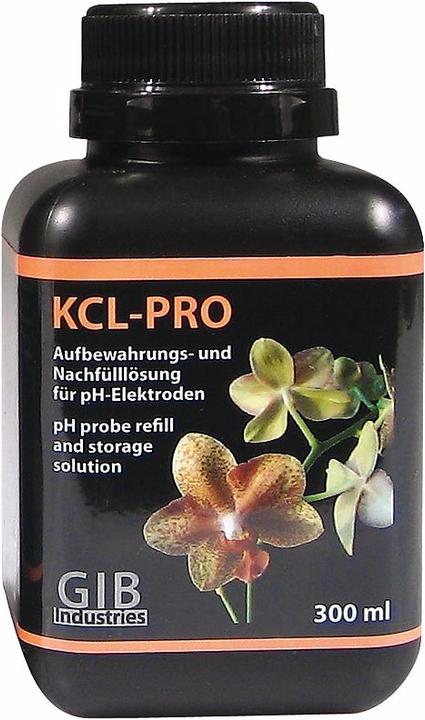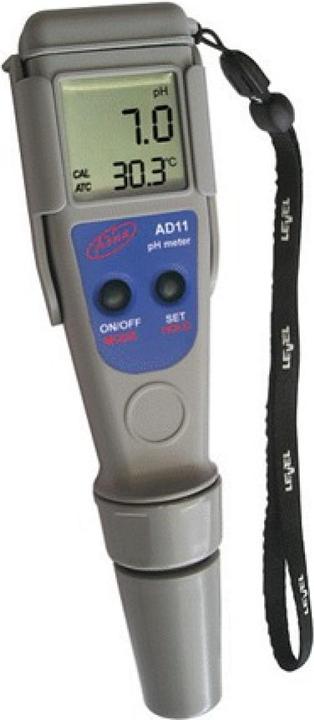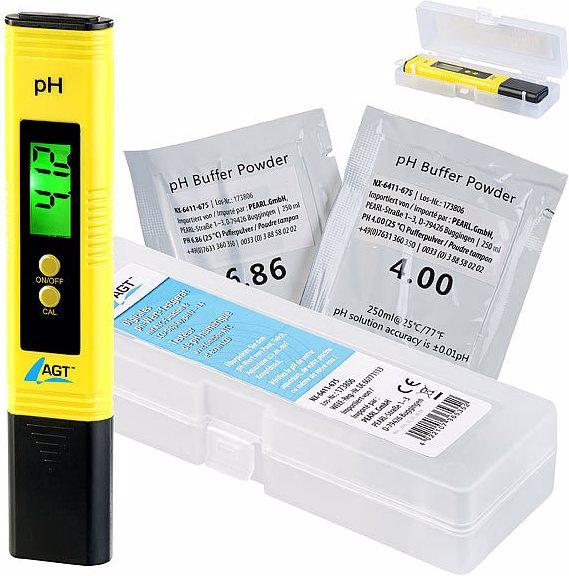

Review: give me paper over this pH meter any day
When I bought this pH meter, I expected it to be electronic, simple and fast. While initially full of hope, I now find myself bitterly disappointed. Time to go back to testing the pool water with paper strips.
When it comes to the water quality of our removable pool, I don’t leave anything to chance. Taking a cool dip on a hot day, the last thing I want to be worried about is what else might be floating in the water along with me. With this in mind, I’ve spent my last four years as an amateur pool boy brushing up on the basics of chemistry. And there’s one thing I pay particularly close attention to: getting the right pH level.
If you ask me, it’s better to take too many pH measurements than too few. So in a bid to make life easier for myself during this year’s pool season, I got myself a digital pH meter:

At just over 40 francs (as of June 2023), I thought I’d recoup the cost of investing in the device quickly enough. Given that a pack of 50 paper test strips also costs just under 20 francs, I assumed I’d break even after about 100 measurements.
I was wrong.
The trouble with the storage solution
In addition to what I initially paid for it, the digital pH meter took a further toll on my bank balance – and my nerves. For starters, I emptied half the storage solution bottle when taking it out of the packaging. In typical me fashion, I’d ignored the instructions. The pH meter was in the bottom of the packaging, and I’d assumed the device was protected by a rubber cap. A mistake, as it turns out. What looked like a protective cap was, in fact, a small container with the storage solution inside. As I read in the instructions later, you’re supposed to carefully remove the bottle from the packaging and store it in an upright position.
My little bottle of storage solution now almost empty, I ordered a new one. Then, while I was waiting for the package to arrive, I also managed to spill the solution I had left. As I was going to take a measurement, I bumped into the table the bottle was sitting on and knocked it over. Admittedly, this was definitely a case of user error. But why on earth doesn’t the bottle have a lid?
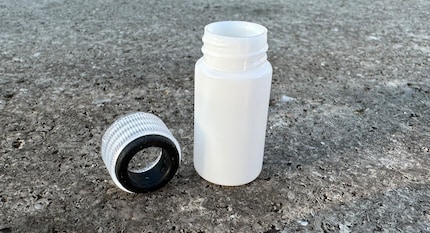
Source: Martin Jungfer
Why am I just seeing dashes?
No sooner had I dealt with the storage solution spillage than the curse of the pH meter struck again. Instead of giving me the pH level of the pool water, all I could see on the display after taking a measurement were dashes. According to the instructions, this happens when the water is too alkaline or too basic. But such a result would be a real surprise. The previous day, the pool water’s pH level had been totally fine. And the brief rainy spell that’d occurred during the night wouldn’t have impacted the readings either. Taking a sample of tap water, I was again presented with dashes instead of a pH level.
Now what? Recalibrate the device perhaps? I took another look at the printed instruction manual:
Calibration is recommended every day if the meter is used often.
But how? The calibration solution needed to do this isn’t included. To find out what a calibration solution even is, I had to to do some research. Research that eventually led me to the world of fishkeeping. I placed yet another order:
Forced to improvise
When the vial arrives, I’m faced with another problem. Although I can get the cap off and squeeze the liquid out, I can’t get the pH meter into the vial.
This means I need to find a container suitable for decanting the calibration solution into. Only then will I be able to calibrate the meter by immersing it in the liquid. Luckily, after a rummage in the basement, I manage to find a small, lid-covered jar. Having a lid means I’ll be able to keep the liquid after I’ve calibrated the device. I squeeze about 30 millilitres of solution from the 50-millilitre vial into the jar. That’s a finger’s breadth of liquid, and enough to completely submerge the pH meter’s diode.
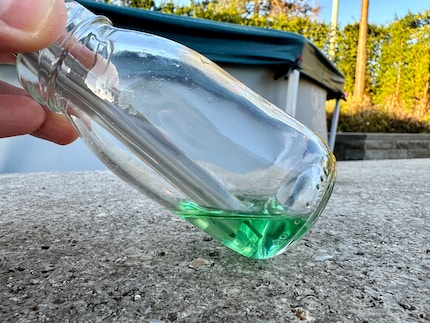
Source: Martin Jungfer
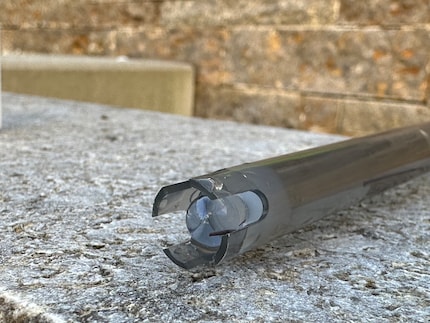
Source: Martin Jungfer
The solution, which has a pH of 7.0, is recognised by the TFA meter as the calibration point. Or, as it says in the instructions, a range of 6.5 to 7.5. Now, that is surprisingly imprecise. I do want to keep the pH level of my pool between 7.0 and 7.4, after all. Fluctuations of 0.5 during the calibration process, then, are pretty counterproductive.
Taking measurements requires the patience of a saint
But whatever, that’s the calibration finished. Time to finally get back to taking measurements. And to do so, I need to muster up a serious amount of patience. As I’m holding the diode in the pool water, the pH level indicated on the display goes up and down. If I move it to and fro – even only slightly – the pH value changes by a few tenths. It takes about a minute to get a stable measurement. Mission accomplished.
Besides its basic purpose, the TFA pH checker has a few additional functions:
- automatic shutdown after 20 minutes when not in use
- automatic temperature compensation (which is also displayed)
- switches between Celsius and Fahrenheit
- «Hold» mode, which «freezes» the currently displayed pH level
I don’t need any of that for my simple pool measurements. All I want to do is take quick, reliable pH measurements – something that takes 20 seconds using paper strips. Taking measurements with the pH meter, on the other hand, involves switching off the device, cleaning the electrode, and putting it back in its storage container. At least its two CR 2032 batteries haven’t needed replacing yet.
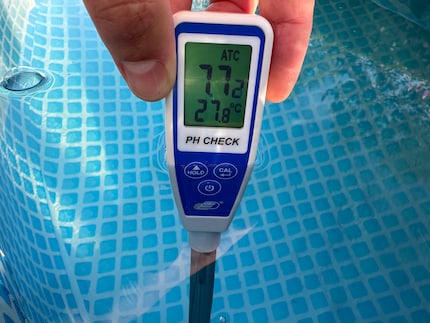
Source: Martin Jungfer
Pool boy Martin is still a paper boy
If I hadn’t committed to reviewing this digital meter, I would’ve chucked it out, sold it or given it away pretty quickly. My plan failed. Taking measurements with the TFA pH meter was neither more accurate nor faster than using cheap litmus paper. The latter can also give you the chlorine content, all in one use.
It just goes to show that the technological solution isn’t always the superior one. One especially irritating thing about the pH meter I tested is that it doesn’t come with calibration solution. Instead, you have to order that separately. A look at other manufacturers reveals that it doesn’t have to be this way.
If you’re interested in pH meters, you’ll find some more here. Personally, I’ve had enough of digital measuring devices for now. In fact, I’ll be going back to using paper strips.
It’ll also save me the hassle created by the dodgy rubber seal on the storage container. I’ve already lost a few drops by storing the device with the box lying flat. Needless to say, I’ll be keeping the box upright from now on. A bit like a makeshift warning sign, aimed at myself.
Is the device the problem, or is it me? Share your experience of using pH meters with the Community and me.
Header image: Martin Jungfer
Journalist since 1997. Stopovers in Franconia (or the Franken region), Lake Constance, Obwalden, Nidwalden and Zurich. Father since 2014. Expert in editorial organisation and motivation. Focus on sustainability, home office tools, beautiful things for the home, creative toys and sports equipment.

